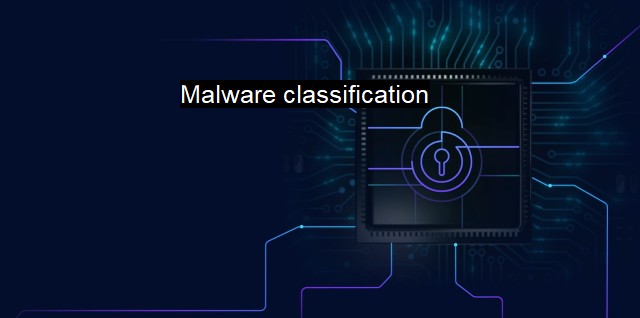What is Malware classification?
Understanding Malware Classification: The Role of Classifying Malware in Cybersecurity Management and Development of Anti-Virus Tools
Malware classification is a subfield within cybersecurity where various types of malware are categorized based on various attributes and behaviors associated with the nature of their cyber-attacks. The primary purpose of creating such classifications is to help cybersecurity consultants devise their protection strategies and to simplify the task of recognizing, diagnosing, and resolving malware-related threats.Malware, in simplistic terms, is a malicious program generated with an intent to harm targeted computer systems, servers, networks, or whole infrastructures. This broad spectrum of malicious aspects can transform into numerous forms including viruses, trojans, spyware, worms, ransomware and many more, each with unique mechanisms and destructive subtleties.
The malware classification process frequently begins by categorizing malware based on its behavior or the form it takes after infiltrating the system. For instance, a worm is a kind of malware that replicates itself to widen its harm, infecting as many user terminals as possible. Viruses, similarly, reproduce and integrate themselves into programs or files and are initiated when the infected program or file is activated. Trojans disguise themselves as an authentic application while clandestinely implementing harmful activities on the system. Spyware stealthily records user activities like keystrokes and sends out the data to hackers, whereas ransomware holds critical data files or the entire systems hostage until an amount is paid.
Malware can also be classified based on the method of entry into a system. malware can be inserted into a system through simple methods such as the user unknowingly downloading the malware, an attacker inserting a USB containing the malware into a device, or even remotely from attacker devices. Determining this primary vector of malware dissemination is often one of the main challenges in the initial stages of responding to a cyber-attack.
The classification of malware may reflect technical characteristics, such as its payload. This term refers to the actions the malware performs that harm devices. a payload could be as straightforward as deleting files or as elaborate as stealing proprietary information. Payloads are often used in determining malware's relative threat level to help prioritize response processes.
In the persistently evolving domains of cybersecurity, automated malware classification systems now use machine learning and artificial intelligence techniques. Various algorithms supervised and unsupervised aid in crucially recognizing, classifying, and fending off cyber threats before they infiltrate systems. This way, the software possesses the ability to learn from prior experiences, thereby enhancing its proficiency to spot and classify malware.
The concept of malware taxonomy is also relevant in this context, as it provides a more in-depth framework for malware classification. A malware taxonomy helps establish common groundbreaking areas in malware threats, mapping the relationships of malware and revealing potential future developments. This is an indispensable tool for cybersecurity researchers who continually grapple with the relentless and rapidly evolving landscape of malware threats and vulnerabilities.
Antivirus software also uses principles of malware classification to identify potential threats and handle them appropriately. For instance, when an antivirus software comes across a foreign code, it inspects the behavior and attributes specific to the malware families in its database. If a match is recognized, the antivirus captures the specimen and neutralizes its attack.
In fact, contemporarily, many antivirus programs can classify potential threats in real-time, thus protecting end users from malicious attacks before any harm can be done to their systems. As technology advances, these systems grow more sophisticated in effectively discriminating against malware's wide array of threats.
It's not easy to overstate the value of malware classification in developing strong defenses against cyber threats on individual devices as well as large-scale networks. By providing insights into potential threats and making us aware of different tendencies and behaviors of malware families, this cybersecurity subfield plays a critical role in devising sturdy defense mechanisms. With malware threats continually increasing in number and sophistication, the function of well-conceived malware classification systems is ever more paramount to successful cybersecurity measures.

Malware classification FAQs
What is malware classification?
Malware classification refers to the process of categorizing different types of malicious software based on their behavior, characteristics, and capabilities. This helps in developing effective antivirus solutions that can detect and prevent malware attacks.Why is malware classification important?
Malware classification is important because it helps in identifying and understanding various types of malware and their potential impact on computer systems. It also helps in developing effective defense mechanisms and strategies against evolving malware threats.What are the different types of malware?
Some common types of malware include viruses, worms, Trojans, ransomware, spyware, adware, and rootkits. Each type of malware has its own characteristics and behavior, which requires different detection and removal techniques.How do cybersecurity experts classify malware?
Cybersecurity experts classify malware based on various factors such as mode of infection, propagation, payload, and behavior. Some common classification methods include signature-based detection, behavior-based detection, and sandboxing.| | A | | | B | | | C | | | D | | | E | | | F | | | G | | | H | | | I | | | J | | | K | | | L | | | M | |
| | N | | | O | | | P | | | Q | | | R | | | S | | | T | | | U | | | V | | | W | | | X | | | Y | | | Z | |
| | 1 | | | 2 | | | 3 | | | 4 | | | 7 | | | 8 | | |||||||